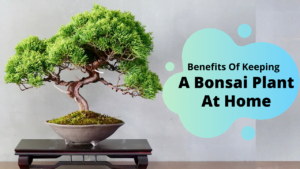Do you know people used ficus elastica tree to build ‘living bridges’ over rivers in regions of India?
In this article, we will cover the growing and caring tips of the rubber tree.
Ficus Elastica Bonsai (Rubber Plant) Key Facts
Ficus Elastica, sometimes known as the rubber tree or rubber plant, is a popular indoor and outdoor gardening plant. The rubber tree derives its name from the thick, sticky white latex that oozes out of the fleshy leaves when they have snapped apart.
It belongs to the Moraceae family of plants, and its latex sap was used to create rubber until synthetics became accessible.
Depending on the age of the ficus elastica bonsai and the time of year, the dark green, waxy leaves turn a deep crimson or purple color at the tips.
Rubber plant thrives indoors and out as long as plant parents give them the right growing circumstances. Established plants can endure cold winter nights without protection because these trees are relatively hardy.
Ficus elastica tree thrives in warm conditions, so you’ll have to bring it inside if you wish to cultivate them. Indoor rubber trees continue to thrive and reach a good height.
You should continually cut the rubber plant ficus elastica back to keep it from becoming out of hand. Outdoor rubber plant ficus elastica is in the same boat. Ficus elastica bonsai placed near walls have the potential to become invasive as they grow in size.
If you’re looking for a unique and beautiful addition to your home or office, indoor bonsai trees for sale are a great option. With a wide variety of species and sizes available, there’s a bonsai tree to suit any taste and space. Bonsai trees also offer many benefits, such as improving air quality and reducing stress. Shop around to find the perfect indoor bonsai tree for you.
What is Ficus Elastic, and where did it come from?
The rubber tree is native to Asia’s southern regions. The Rubber plant has a viscous sap initially employed as an ingredient in bouncing balls by Mesoamerican indigenous tribes, earning it the nickname. They have air-purifying properties and can grow very strong roots, which is why they are used to build ‘living bridges’ over rivers in regions of India.
Many people believe that the spherical leaves of this rubber plant symbolize richness, happiness, and wealth. Rubber plant ficus elastica is the ideal plant to place in a home corner.
Caring for the Rubber Tree (Ficus Elastic) Bonsai
Rubber Plant Bonsai Sunlight Requirements
Keep your rubber plant in a sunny area whenever possible. Keep it away from windows that receive direct sunlight, as the scorching sun can burn the plant’s leaves. Observing how close new leaves grow together on your rubber tree is a useful method to detect if your bonsai is getting enough sunlight. You should move the ficus elastica tree closer to the window if it becomes lanky and looks to be reaching for the light.
Rubber Tree Bonsai Temperature Tolerance
Ficus elastica tree has thicker leaves that may hold a lot of moisture. It indicates they should be fine in a room with normal humidity (temperatures of 16-24°C). If your rubber plant is near a radiator, spritz it frequently or use a humidifier to ensure it gets the moisture it requires.
Maintenance
It’s best to wipe down ficus elastica bonsai leaves using a dust cloth to keep them looking bright and healthy. If your rubber plant ficus elastica grows quickly, you should check its roots once spring arrives. It’s time to repot if the roots are poking through the drainage holes in your pot. Always make sure you’re using the proper soil type and only slightly scaling up while repotting. Make sure your Ficus elastica bonsai has well-draining soil so it can dry out between waterings.
Fertilizing:
The ficus elastica bonsai loves to be supplemented with fertilizer for its growth. Fertilize your tree through the growing season, meaning from spring to summer. But back off during the fall and winter months. As a general rule of thumb, giving fertilizer during watering sessions is a good idea. You can use a liquid fertilizer, mix it in your water and simply apply it.
Powder and granular fertilizers also can be used, but liquid fertilizer seems easier to me, I am at peace knowing my plant is evenly fertilized.
Make sure to follow the instructions label of your fertilizer and use it accordingly. I like using half of the suggested fertilizer dose with the rubber bonsai tree. Using too much fertilizer will cause your tree to get fertilizer burns.
Rubber Tree Bonsai Pruning
Even in the absence of nutrients in the soil, the ficus elastica tree grows aggressively. If you’re growing your rubber tree, you’ll need to prune it in the middle of the growing season and again at the end of the fall.
Pruning fosters new development, so keep your ficus elastica bonsai tree away from any walls or other trees.
Note:
- Use a sharp saw or a sharp pair of scissors for rubber plant ficus elastica during pruning. Always wear protective gloves to avoid putting liquid latex on your skin when pruning.
- Pruning your rubber tree regularly will encourage it to branch out.
- Ficus elastica tree should be pruned once or twice a year, preferably at the end of the summer and winter.
- There’s no need to aggressively prune the rubber plant; mild pruning would be enough. It will aid in the growth of more dense and attractive leaves.
Rubber Plant Bonsai Watering
Before watering your ficus elastica bonsai, inspecting the soil is always good. You can use a technique of a three-inch plunge of your finger into the earth. You don’t need to water the rubber plant if your finger comes out with earth adhered to it. It’s time for a drink if your finger comes out clean. Your plant’s leaves may be turning yellow or falling off as a result of overwatering.
To avoid overwatering, make sure you water your rubber plant ficus elastica bonsai evenly and let it drain fully so the roots don’t sit in a puddle of water. It can lead to root rot, which can kill your rubber plant.
During the spring and summer, it’s also a good idea to give your ficus elastica tree a monthly dose of liquid fertilizer. If you don’t want to startle your rubber plant, dilute the fertilizer with water. It will provide it with the nutrition it requires to continue to grow tall and gorgeous.
Note:
- Once a week, water the ficus elastica bonsai, but wait until the soil is completely dry before watering again.
- Misting the leaves on a frequent basis will improve the quality of the leaves and prevent them from drying up, especially in the winter when the heating is on full blast.
- Ficus elastica benefits include cleaning the leaves with a damp rag or paper towel on a regular basis.
Propagate Rubber Tree Bonsai
Rubber tree propagation is simple if you know what you’re doing. There are two techniques of propagation that have been confirmed to process.
First Method
- Take a branch off the tree and cut it.
- Leave a branch to bleed out after cutting it at a 45-degree angle.
- Placing the limb in some water and covering the bottom of the branch once the latex has dried.
- In a few weeks, you will witness new roots emerging.
- Plant the ficus elastica tree in a flowerbed or a pot once the roots have appeared.
Second Method
- Cutting the branch 80 percent of the way through.
- Insert a toothpick into the cut, then pack moss into and around the wound.
- Plastic wrap the moss and rubber tree branch and set aside for two weeks.
- Cut the branch off the ficus elastica tree and put it in a prepared container after you see the new roots emerge through the moss.
Rubber plant tree potting and repotting:
When you receive your new rubber bonsai tree, there are a few things you need to consider about potting. Rubber plant loves it when their root system is a bit bounded. So use to pot the same size as its root system or slightly bigger.
The rubber bonsai tree enjoys it when the soil is well-draining. An all-purpose indoor mix soil will be great, but you should add some extra perlite to elevate its draining power.
Good drainage is the key, so to make the draining even more effective take a scoop of pebbles or gravel and spread spread at the bottom of the pot. Then place the tree and fill the pot with the potting mix. To make sure your bonsai remains nice and straight, use your hand to push the soil down as you move around the pot. Once the sides are sealed, place a thin layer of soil over the top of your tree.
Tip:
After the potting, you might notice your tree losing some of its leaves, but it’s not alarming, they are just getting used to it, be gentle with them and give them some time to adjust.
Repotting:
As I said, rubber bonsai don’t mind being a little potbound (in fact they love it), but you’ll know it’s time to repot when you notice roots escaping from the holes in the base of the pot or appearing to pick out of the pot from the soil surface. When repotting, pick a pot that’s no more than three inches larger in diameter than the prior pot.
Common Problems with a Ficus Elastic Plant
Yellowing or wilting leaves
The most prevalent issues of rubber plant ficus elastica bonsai are mainly related to irrigation. When leaves are overwatered or underwatered, they turn yellow. It can make determining what’s wrong with your plant difficult.
Take a look at the soil as a starting point. Check the soil with your fingers to see if it’s dry. If it’s still very damp, check your plant’s roots for any signs of root rot. The roots may be mushy, the soil may smell terrible, and the roots themselves will be reddish-brown in color.
It’s always easier to fix your ficus elastica tree if you’re not watering it enough than overwatering it.
Dropping Leaves
Ficus elastica bonsai will drop their leaves if they do not receive enough sunlight. If the humidity isn’t high enough, they’ll drop them. Move them closer to the light and spray them every few days to keep plants happy.
Curling leaves:
If the leaves are starting to bend on your Ficus elastica tree, it’s time to get down and messy with the soil. Both excessive and less watering are the reason for this issue, so you’ll have to set a new watering schedule. You should allow the soil to completely dry between waterings, and then water it thoroughly until you notice it leaking through the drainage holes in the base of the plant pot.
Curling leaves could also be expected to be derived from low humidity. If you’re suffering from dry indoor air, up the moistness with a mister or humidity tray to provide your tree with the more sauna-like surroundings they’re craving.
Unwanted pests
Just like any other houseplant, your Ficus elastica tree may attract unwanted pests. It’s always good to inspect your new plant’s leaves before taking them home from the nursery. Here are some of the common intruders you may come across in your Ficus elastica tree;
Aphids:
Aphids are small, oval-shaped pests that assemble in large numbers on the underneath leaves of the Ficus elastica tree. They can also reside on the joints of leaves and stems. The pests are normally green but can be found in other colors, for instance red, brown, black, or yellow. Aphids harm rubber bonsai by sucking the fluid from the leaves.
Scales:
Scales are common rubber tree pests that leach themselves to all elements of the plant and, like aphids, they suck on sweet plant saps. Scale pests might be either armoured scales, with a shell-like outer surface, or velvety, with a waxy or cottony texture.
Spider mites:
Spider mites are hard to notice with the bare eye, but they are severe rubber tree pests that stab the leaves to pull out the juice. You will know spider mites have been infested on the tree because of their telltale nets or webs. They usually occur when the atmosphere is dry and dusty.
Thrips:
Thrips are small rubber bonsai pests with wings. The pests, which may be black or yellow-colored, hop or fly if you shake the branches. Thrips are more problematic for outdoor rubber bonsai plants, but they can also invade plants living indoors.
Solution:
Insecticidal soap solutions are usually sufficient against Ficus elastica tree pests, but you may have to apply them every couple of weeks until you get rid of them. Use a commercial product, as homemade sprays are usually too intense for indoor plants. Neem oil is also an alternative.
Horticultural oils kill pests by suffocation and are extremely useful against challenging rubber tree pests like scales and thrips.
Chemical insecticides should be employed only as a last alternative. If you use chemicals, be certain they are okay for indoor use.
Frequently Asked Questions
Ques: Is ficus elastic tree Toxic?
No, ficus elastica bonsai are not toxic. If you cut the stems and snap the leaves apart, you’ll see that they leak a milky-white liquid. Rubber producers worldwide want this latex, and it’s used as a base ingredient in a variety of industrial rubber compounds.
If you have latex sensitivity, the sap may cause moderate irritation if it gets on your skin. If you eat any of the tree’s parts, it could result in a trip to the emergency department.
Ques: What Soils is Good for ficus elastica bonsai?
Rubber trees thrive in a wide range of soil conditions. They love somewhat acidic soil, although they thrive in various circumstances as long as proper drainage is there.
Dig a large hole large to accommodate the root ball before planting your ficus elastica tree. Planting too deeply could cause the tree to die back.
Your bonsai doesn’t require soil amendments. Ficus elastica bonsai don’t need fertilizer during the growing season. If you’re struggling to control the tree’s growth, adding compost to the mix might quickly escalate the situation.
Conclusion
The Ficus elastica tree, or rubber plant, is a fantastic alternative if you’re searching for a low-maintenance plant that’s a little different than the normal plants that end up on ‘hard to kill’ lists.
Ficus elastica bonsai trees have lustrous leaves, come in a variety of colors, and thrive well. They behave more like trees than conventional plants, making them a great focal point for your home.
Related Articles
- Bonsai for Beginners in India [Update 2024]
- 15 Best Plants for Front Door Entrance India | Auspicious plants for front door
- 10 Study Table Decoration Ideas That Will Make You Love Learning
- Revive Your Bonsai Tree with These Proven Techniques!
- Top 15 Benefits of Bonsai Plants that will Make your Life Awesome
- Top 10 Indoor Plants for Cafes to Enhance Decor & Comfort







